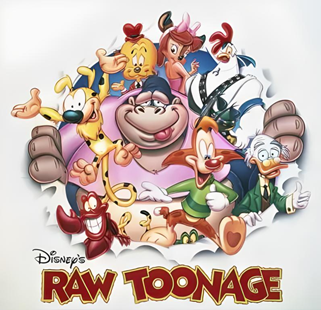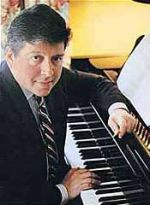
The Electric Company is an American educational children's television series produced by the Children's Television Workshop. It was co-created by Paul Dooley, Joan Ganz Cooney, and Lloyd Morrisett. The series aired on PBS for 780 episodes over the course of its six seasons from October 25, 1971, to April 15, 1977. The program continued in reruns until October 4, 1985. The Electric Company later reran on Noggin, a channel co-founded by the CTW, from 1999 to 2003. Noggin also produced a compilation special for the show.

Raw Toonage is an American animated series that aired on CBS. It premiered on September 19, 1992. The show was cancelled on December 5 after 12 episodes had been broadcast.
Paul Fierlinger is a creator of animated films and shorts, especially animated documentaries. He is also a part-time lecturer at University of Pennsylvania School of Design.

KaBlam! is an American animated sketch comedy anthology television series that ran on Nickelodeon from October 11, 1996 to January 22, 2000, with repeats until November 2, 2001. The series was created by Robert Mittenthal, Will McRobb, and Chris Viscardi. The show was developed as a fully animated showcase for alternative forms of animation that were more common in indie films and commercials. Each episode thus features a collection of short films in different innovative styles of animation, bridged by the characters Henry and June, who introduce the short animations and have zany hijinks of their own in between.


The New 3 Stooges is an American animated television series that ran during the 1965–66 television season starring the Three Stooges. The show follows the trio's antics both in live-action and animated segments. The cast consisted of Moe Howard, Larry Fine and Joe DeRita, with actor and close friend Emil Sitka co-starring, as well as Margaret Kerry. The stories took place in varied settings, including a California beach and sailing as buccaneers on the Spanish Main.
Saturday TV Funhouse is a segment on NBC's Saturday Night Live featuring cartoons created by SNL writer Robert Smigel. 101 "TV Funhouse" segments aired on SNL between 1996 and 2008, with one further segment airing in 2011. It also spawned a short-lived spinoff series, TV Funhouse, that aired on Comedy Central.

Joseph Guilherme Raposo, OIH was an American composer, lyricist, songwriter, singer, and pianist, best known for his work on the children's television series Sesame Street, for which he wrote the theme song, as well as classic songs such as "Bein' Green", "C Is For Cookie" and "Sing". He also wrote music for television shows such as The Electric Company, Shining Time Station and the sitcoms Three's Company and The Ropers, including their theme songs. In addition to these works, Raposo also composed extensively for three Dr. Seuss TV specials in collaboration with the DePatie-Freleng Enterprises: Halloween Is Grinch Night (1977), Pontoffel Pock, Where Are You? (1980), and The Grinch Grinches the Cat in the Hat (1982).

Mo Willems is an American writer, animator, voice actor, and children's book author. His work includes creating the animated television series Sheep in the Big City for Cartoon Network, working on Sesame Street and The Off-Beats, and creating the popular children's book series Elephant and Piggie.

Big Bag is an American live-action/animated children's television series created by Nina Elias-Bamberger for Cartoon Network and Children's Television Workshop. It was targeted at preschool viewers. The show was co-produced by Cartoon Network and CTW, with Muppet characters created by the Jim Henson Company. It aired from 1996 to 1998, with reruns airing through 2001, alongside another program titled Small World. Localized versions of Big Bag aired on Canal J in France and Yorkshire Television in the UK.

James Frederick Thurman was an American actor, writer, director, cartoonist, and producer. He is best known for the writings of TV gags for the likes of Bob Hope, Bob Newhart, Carol Burnett, Bill Cosby, and Dean Martin.
John Korty was an American film director and animator, best known for the television film The Autobiography of Miss Jane Pittman and the documentary Who Are the DeBolts? And Where Did They Get Nineteen Kids?, as well as the theatrical animated feature Twice Upon a Time. He has won an Academy Award for Best Documentary Feature and several other major awards. He is described by the film critic Leonard Maltin as "a principled filmmaker who has worked both outside and within the mainstream, attempting to find projects that support his humanistic beliefs".

Secret Squirrel is a cartoon character created by Hanna-Barbera and also the name of his segment in The Atom Ant/Secret Squirrel Show, which debuted in 1965. He was given his own show in 1966, titled The Secret Squirrel Show, but was reunited with Atom Ant for one more season in 1967. The half-hour The Secret Squirrel Show included three individual cartoon segments: "Secret Squirrel", "Squiddly Diddly" and "Winsome Witch". Secret Squirrel first appeared in a prime-time animated special called The World of Secret Squirrel and Atom Ant, which aired on NBC on September 12, 1965.
A wide variety of characters have appeared on the American children's television series Sesame Street. Many of the characters are Muppets, which are puppets made in Jim Henson's distinctive puppet-creation style. Most of the non-Muppet characters are human characters, but there are many characters that are animated.
The Truth About Mother Goose is an animated film released on August 28, 1957, by Walt Disney Productions. The short was directed by Wolfgang Reitherman in his directorial debut, and Bill Justice, and written by Bill Peet.

Don't Hug Me I'm Scared (DHMIS) is a British musical horror comedy web series created by Becky Sloan and Joe Pelling. The series is notable for its blending of surrealism and morbid humour with elements of psychological horror and musicals. Its production is also notable for diversity, combining puppetry, live action, and styles of animation including stop motion, traditional animation, flash animation, clay animation, and computer animation. The original series consisted of 6 short episodes released from 29 July 2011 to 19 June 2016 on YouTube. A follow-up television series was released in 2022 on All 4 and Channel 4.












